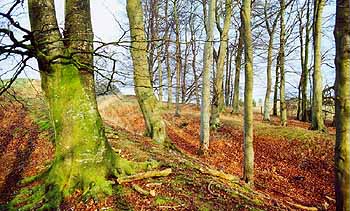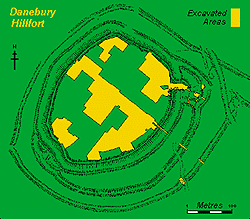
EBK Home
Kingdoms
Royalty
Saints
Pedigrees
Archaeology
King Arthur
Mail David
 BATTLE
OF GUOLOPH
BATTLE
OF GUOLOPHChattis Hill in Nether Wallop?
The Tradition: In his Historia Brittonum, Nennius' recorded that
"From the reign of Vortigern to the quarrel between Vitalinus and Ambrosius are twelve years, that is Guoloppum, the Battle of Guoloph"
Guoloph is generally thought to refer to the Wallop Brook in North-West Hampshire, the battle having taken place at one of the three villages which take their names from the stream: Over, Middle and Nether Wallop.
Modern Archaeology: In the Parish of Nether Wallop, just North-East of the village of the same name, stands the great Iron-Age Hillfort of Danebury. This has been the subject of a major excavation by Professor Barry Cunliffe and his team over a period of some twenty years. From 1968 to 1988, fifty-seven percent of the interior of the fort was excavated and extensive evidence for Iron Age occupation was recorded: numerous finds, 2500 pits, 500 storage buildings and seventy houses identified from the maze of some 10,000 post-holes. There was no evidence of occupation during the Roman period but, at some undefined later stage, the defensive outer ditch was redug. The sides of the silted up V-shaped channel were cut back to make them vertical and the spoil dumped in the interior to form a 36ft wide, flat-bottomed ditch, 61/2ft deep: quite an obstacle. The hornworks of the Eastern Entrance were also heightened. Possible
Interpretation: Though there is
no direct dating evidence for this reconstruction of the defensives at
Danebury, unstratisfied sherds of 5-6th century coarse grass-tempered
pottery have been recovered from the fort's interior. This would indicate
a major refortification of the site at the exact time that Kings Vitalinus
(Vortigern) and Ambrosius are recorded to have been active in the area!
The latter may be remembered just to the north in nearby Amport.
Place-name evidence indicates that there was an extensive survival of
Celtic culture in this region. Names such as Micheldever (Boggy Stream)
and Andover (Anu's Stream) are dead give-aways, while further
"An" names may infer a strong regional cult surrounding the
Celtic Goddess, Anu. Danebury
(earlier Dunbury) may itself derive from her alternative name, being
"Don's Bury" (or it may merely show a combination of the Celtic
word for fort, Din, and the Saxon translation of Bury).
Could it be that the great Ambrosius himself refortified Danebury just
prior to the Battle of Wallop in AD 437? If so, was his clash with
Vitalinus (Vortigern) actually fought there? There is no archaeological
evidence to support such a theory, and it seems probable that the battle
actually took place just to the south, where the enemy may have taken up a
strategic position on what the Celts remembered as Cad (ie.Battle)
Hilll, now called Chattis Hill on the borders of Nether Wallop and
Broughton.
Possible
Interpretation: Though there is
no direct dating evidence for this reconstruction of the defensives at
Danebury, unstratisfied sherds of 5-6th century coarse grass-tempered
pottery have been recovered from the fort's interior. This would indicate
a major refortification of the site at the exact time that Kings Vitalinus
(Vortigern) and Ambrosius are recorded to have been active in the area!
The latter may be remembered just to the north in nearby Amport.
Place-name evidence indicates that there was an extensive survival of
Celtic culture in this region. Names such as Micheldever (Boggy Stream)
and Andover (Anu's Stream) are dead give-aways, while further
"An" names may infer a strong regional cult surrounding the
Celtic Goddess, Anu. Danebury
(earlier Dunbury) may itself derive from her alternative name, being
"Don's Bury" (or it may merely show a combination of the Celtic
word for fort, Din, and the Saxon translation of Bury).
Could it be that the great Ambrosius himself refortified Danebury just
prior to the Battle of Wallop in AD 437? If so, was his clash with
Vitalinus (Vortigern) actually fought there? There is no archaeological
evidence to support such a theory, and it seems probable that the battle
actually took place just to the south, where the enemy may have taken up a
strategic position on what the Celts remembered as Cad (ie.Battle)
Hilll, now called Chattis Hill on the borders of Nether Wallop and
Broughton.
